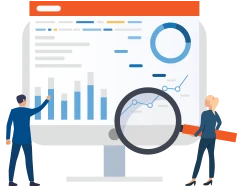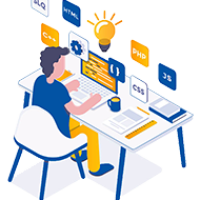Let’s Build What’s Next for Your Business
Your software should do more than run, it should scale, secure, and support your business growth. That’s where we come in.

Konverge Home » Services » Business Analysis for Software Development
Constructing custom software solutions is a multifaceted process, like building a house. At Konverge, we incorporate business analysis into every custom product development project we undertake. A builder needs a blueprint before construction begins. Software development also requires a detailed plan. This is where our business analysis services come into play—it serves as the blueprint for our custom software development process.
Business analysis for software development plays several important roles:

A business analyst serves as a bridge between stakeholders and the development team. They help identify and translate a business idea or business needs into clear software requirements that align with the business goals.

By thoroughly analyzing business processes and clearly defining business requirements, we make sure that all project documentation that will guide the development process accurately reflects your goals and priorities.

Defining the project's scope is essential for effective project management. Business analysis consulting helps prevent scope creep—the tendency for the project to expand beyond its original objectives.

Business analysts can anticipate potential risks and determine solutions to mitigate them, saving time, effort, and costs.

Business analysts facilitate communication between stakeholders, developers, and other project members, ensuring collaboration and consensus.

Through continuous monitoring and feedback, business analysts can help improve the quality of the solution, ensuring it satisfies the users' needs and preferences.

Business analysts help increase the return on investment by focusing on delivering value. They prioritize the most valuable features to be developed, ensuring that the software offers the maximum benefit to the business.
At Konverge, we adopt a strategic and comprehensive approach to business analysis, tailoring it to the unique needs of the stakeholders in the wide range of industries we serve.
We are committed to fostering transparency, maximizing value, and ensuring alignment with our client’s objectives throughout the business analysis process. Our process typically includes the following stages:
Understanding stakeholders’ roles and expectations is crucial for success. We begin by identifying all parties who the software solution will impact. This includes our direct client and their customers, employees, suppliers, or other individuals with a vested interest in the software’s success. This collaborative approach ensures the software addresses not only immediate needs but also long-term goals and opportunities for innovation.


We work closely with the identified stakeholders to gather comprehensive requirements. Using techniques like interviews, surveys, workshops, and direct observations, we understand what the software needs to achieve and why it is needed. By fostering open dialogue, we bridge gaps between stakeholders’ expectations and technical feasibility, ensuring the software delivers real-world solutions that are practical, scalable, and user-friendly.
Konverge emphasizes actionable documentation by aligning requirements with business goals and development priorities. The gathered requirements are then scrutinized for clarity, consistency, and relevance, removing any ambiguities or redundancies. Once refined, these requirements are documented in a clear and accessible format, serving as a roadmap for the software development process.


The documented requirements are then validated with stakeholders to confirm they precisely mirror the desired outcomes. Through collaborative reviews and real-time feedback, we validate not just the “what” but also the “why” of each requirement. This validation process ensures all parties share a common understanding of the project goals, minimizing potential misunderstandings down the line.
We recognize that requirements can evolve as the project progresses. Our team adeptly manages and tracks changes to the requirements, maintaining open communication with stakeholders to keep everyone informed of any alterations. This dynamic approach to managing requirements ensures transparency and adaptability.


Once the software is developed and implemented, we evaluate its performance against the initial requirements. Evaluation extends beyond technical performance—we assess user satisfaction and business alignment. We assess whether the solution has successfully delivered the desired outcomes while uncovering areas for further optimization.
The result is a final requirements document, often called a Software Requirements Specification (SRS) document, which comprehensively describes the intended purpose and environment for software under development. This document defines what the software will do and how it will perform. It serves as an agreement between the customer and the developer and is a critical element in software development.
The System Requirement Specifications include the following sections
To set the stage for successful development, we craft the introduction to clearly communicate project scope, goals, and constraints. This section gives an overview of the purpose, scope, definitions, acronyms, abbreviations, references, and overview of the SRS. This fosters alignment among stakeholders, helping teams focus on a unified vision while addressing potential challenges early in the project lifecycle.


This section provides a general description of the software product perspective and functions, including user needs and system constraints, anticipating challenges before they arise. By mapping dependencies and assumptions, we create a clear blueprint that supports proactive decision-making throughout the development process.
This is the main section of the SRS, detailing all the requirements of the software. This includes functional requirements, performance requirements, design constraints, logical database requirements, user interface requirements, etc.
Each requirement is paired with actionable insights and traceability to ensure it aligns with project goals. Our structured approach makes it easier to prioritize high-impact features, ensuring the development team focuses on what delivers the most value first.


These include criteria used to judge a system’s operation rather than specific behaviours. This could consist of reliability requirements, efficiency requirements, maintainability requirements, usability requirements, etc.
These requirements extend beyond operational benchmarks, addressing user experience and system longevity. By incorporating maintainability, security, and usability into the planning process, we future-proof your software and ensure it continues to meet business needs as technology evolves.
This includes all other information that is related to the SRS. This could include sample inputs/outputs, results of feasibility studies, etc. These resources empower development teams and stakeholders to make informed decisions, streamlining collaboration throughout the project lifecycle.

